Blame it on Bruce Chatwin or Yvon Chouinard. Or, maybe more positively, credit
it to a desire to experience one of the world's acclaimed wild places.
Chatwin created my fascination with his book, "In Patagonia." First
published in 1977, the book launched a worldwide awareness of a region sometimes
called "the uttermost part of the Earth." Patagonia is the stretch
of land at the southern tip of Chile and Argentina, the take-off point for travels
to the Antarctic, where Butch Cassidy and the Sundance Kid hid, where Charles
Darwin evolved theories about evolution.
Chouinard created Patagonia, a brand of quality outdoor clothing. In one of
the company's early promotional brochures, Patagonia was described as conjuring
"romantic visions of glaciers tumbling into fjords, jagged windswept peaks,
gauchos and condors." Unusually, that vision is more than an advertising
message.
 |
|
|
Patagonia's peaks rise like cathedral spires
|
April isn't the usual time for Patagonia travels. Most trekking is done in December
and January, when it's summer in South America. As I learned, when it's spring
in the United States, it's late fall in Patagonia. At times, snow and rain made
conditions miserable. Gusts of wind sent me spinning sideways. One particularly
weather-weary day, when I let my backpack get sideways to the wind, a roaring
blast sent me tumbling helplessly into a stream. I had been warned of Patagonia's
fearsome winds by my daughter, Molly, who had traveled the same path more than
a month earlier. Actually, she and a friend had traveled the longer 10-day circuit
around Parque Nacional Torres del Paine. Her photos include a shot of their
tent pitched in deep snow and burdened backpackers clomping over snow-packed
mountain passes. I was backpacking the "W," a shorter route that includes
many highlights from the longer trek. Because of the season, the usual hordes
of hikers were missing, but so was the sun. My arsenal of long underwear, gloves,
rain pants and rain jacket, goose down jacket, wool hat and other cold weather
gear was well-used.
Actually, the weather determined my route. Heavy snows made travel north from
the Las Torres up the east side of the "W" impassible, so I stayed
on my bus to the Refugio Pudeta and took the half-hour catamaran ride across
Lago Pehoe to Pehoe Refugio. From there I hiked along Lago Grey to the Glacier
Grey campground. On the bus ride from Puenta Arenas, the skies had occasionally
cleared. We stopped at an overlook in the park where the views, well, let my
journal impressions suffice: "There is nothing that can really prepare
you for the mountain, which are a lot like cathedral spires, but not to the
God we know. Erratic. Chiseled. Tortured. Like bad flintknapping done unintentionally
beautiful."
The hike to the campground at Glacier Grey felt longer than supposed 11 kilometers.
It was cold and wet, the trail often obscured by fresh snow. My campsite had
a view of Lago Grey, but my tent's rainfly was quickly sliced by fierce winds.
(Before my time in Patagonia ended, I gave away my old tent, a pair of weathered
hiking boots that literally fell apart and trashed long-time shirts and pants
so worn and tattered they would have embarrassed Chouinard.) But that night's
dinner, an Alpine Aire Foods chicken rotelle dinner, capped the splendidly wild
day.
 |
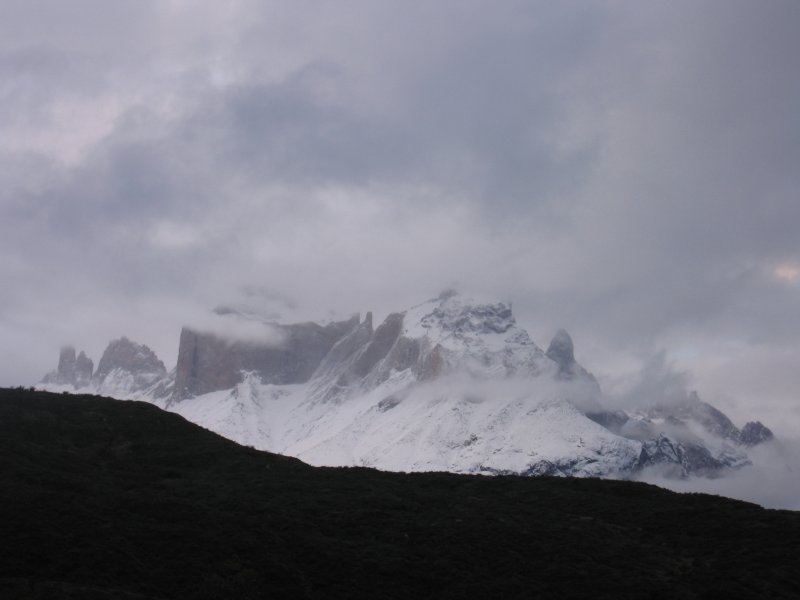 |
|
Torres in the clouds
|
Peek-A-Boo in the peaks
|
During the days that followed the weather mostly stayed fickle. My backpack
cover disappeared, but a following group of hikers retrieved and returned it.
One day I took a wrong turn and spent more than an hour aimlessly wandering
until becoming completely bogged down in a snow-filled gully and backtracking.
At Campo Italino, a bleak campground, two red-backed hawks cajoled and squawked,
hoping to poach food. The hike up to Campo Britancio would have been easier
with snowshoes.When I arrived at the hostel at Los Cuernos, there wasn't a dry
part on my body. After nearly filling a bucket with water from my boots and
my wrung-out socks, I almost quit for the day. Instead, only semi-dried out,
I continued on, rewarded with jaw-dropping views of hanging glaciers, sightings
of spiraling condors and warming temperatures.
 |
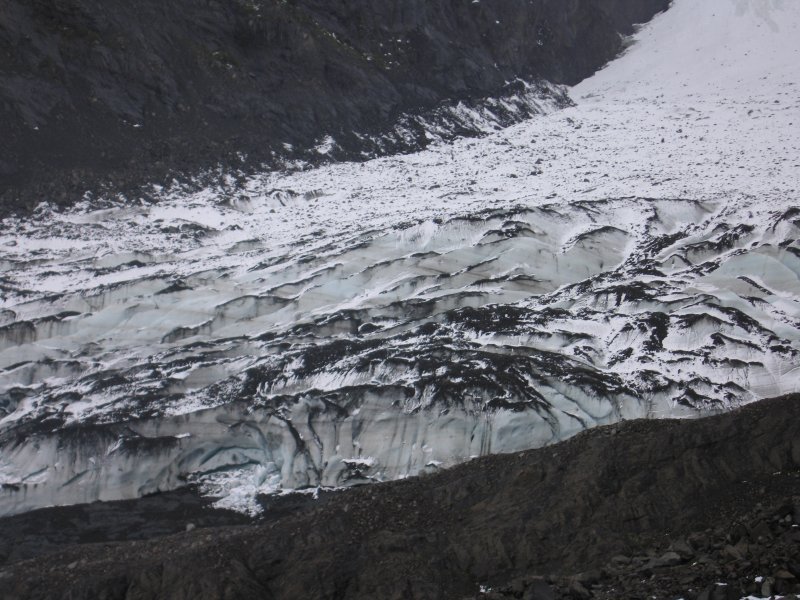 |
 |
|
Hiker on suspension bridge at Italino
|
Valle del Frances waterfall
|
RAGGED GLACIER DEL FRANCES
|
Actually, every day was a great day. There were dazzling views of the ragged
Glacier del Frances, a night sky luminously littered with constellations, a
thrilling, sometimes chilling array of funky bridges. Clouds filtered in and
out, playing peak-a-boo with the jagged mountaintops. Again from my journal,
"This was one of the best miserable days I've ever enjoyed. A real Patagonia
experience."
 |
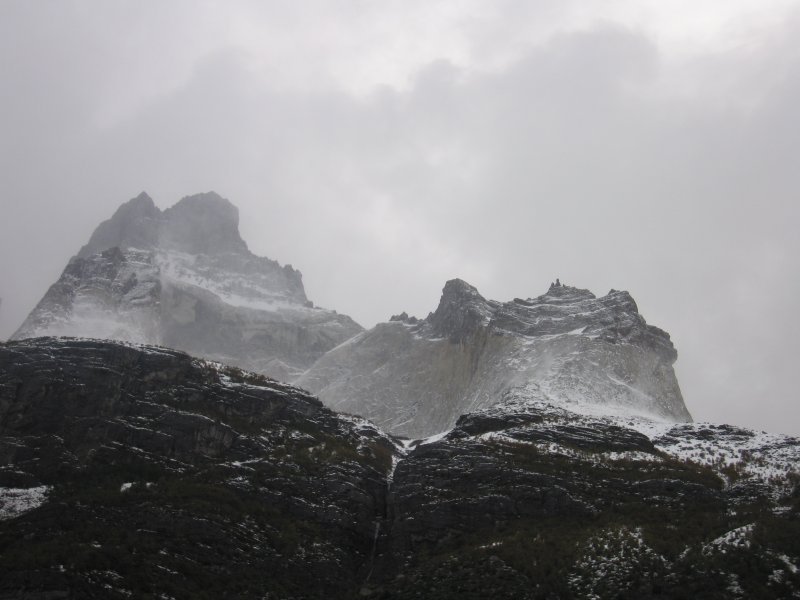 |
|
Los Curenos cabanas
|
Clouds obscure peaks
|
Before the trip I'd been assured I would hook up with other backpackers, but
that never happened. Instead, most people holed up at the comfortable refugios
at Lago Grey and Las Torres. Some made day trips while others, I learned later,
huddled inside reading books about adventure while slurping beer or bottles
of fine Chilean wine.
My final night at Las Torres I yielded. After a sloppy wet day, I walked past
the luxury hotel with affluently dressed tourists and the campground. Instead,
I rented a bunk at the refugio, where I savored a hot water shower and slurped
two glasses of wine while economically cooking a tasteless freeze-dried dinner.
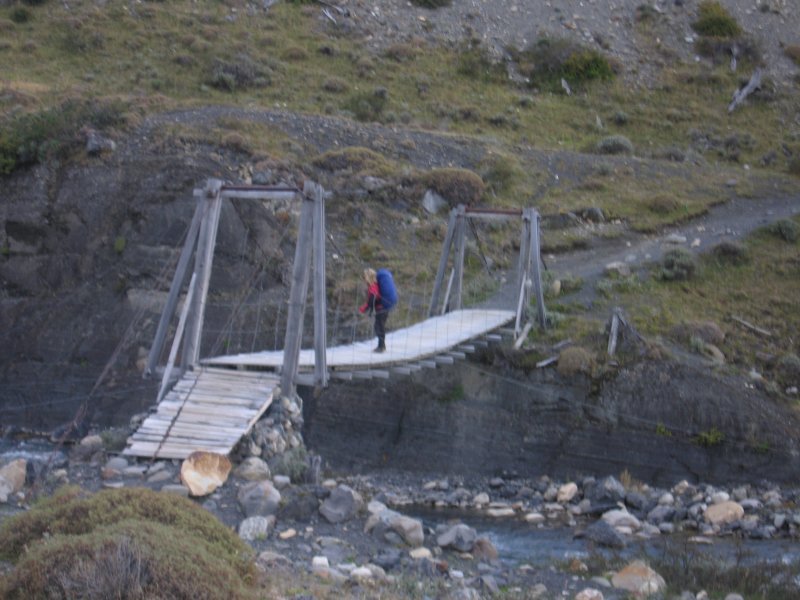 |
 |
|
Crossing another suspension bridge
|
Torres at sunset
|
The next day, everything changed. At twilight the clouds parted and two of the
Torres del Paine, a trio of tower-like peaks that give the park its name. I'd
planned to sleep in the next morning, but the rustling sounds of awakening hikers
changed that. It was 5:30 a.m., but the night sky sparkled with stars. In 15
minutes I was out the door. Using a headlamp, I hiked alone, hoping I was following
the correct route. Nearly two hours later, with the first splashes of light,
I passed the boarded-up Chileno Refugio. A knotted rope provided traction up
a washed out section of trail, which crossed swinging suspension bridges and
bridges made from fallen trees laid side-by-side. The miles passed quickly,
until the endlessly steep final section up treacherous, ice-slick slopes. Beacons
of morning light washed the sky in soft reds and blues and, on the Torres, subtle
textures of white.
Suddenly I reached the mirador, the viewpoint above a glacial lake where I gaped
at the trio of massive, dramatically irregular spires that are the Torres. Like
others who joined me, I was speechless. We just looked, bewildered, disbelieving
and humbled.
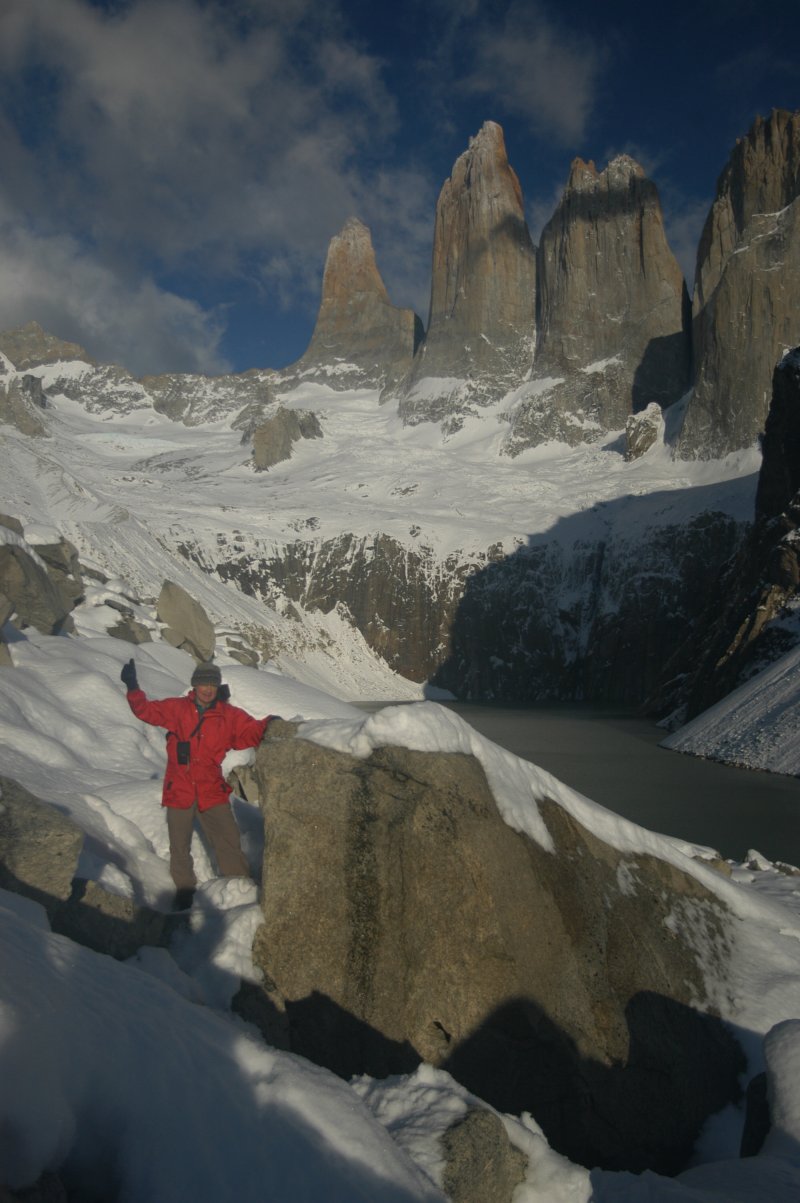 |
|
|
Lee at the Torres Mirador
|
In the days that followed I was awed by scenery graciously revealed as the clouds
gave way to bluebird skies. Back in Puenta Arenas, the Patagonia town where
most Torres del Paine base their travels, my freeze-dried meals were replaced
by sumptuous feasts that included conger eel marinated in king crab sauce, cordero
parrillo (lamb cooked over hot coals and basted with remarkable sauces), calafalte
(the local berry) moose, and glasses of titillating, intoxicating piso sour,
a potent brandy made from distilled grapes. But I remembered the reality of
my travels in Torres del Paine and the silencing grandeur of the Torres. Hard-earned
travels, but intoxicating and wildly delicious Patagonia travels.
Lee Juillerat is the regional editor for the Klamath Falls Herald and
News in Oregon. He also does freelance writing and photography for several magazines,
including Northwest Travel, Oregon Coast, Horizon in-flight, Range and others.
His travels take him around the country and world, often checking up on his
daughter, Molly. His contact email address is lee337@cvc.net.